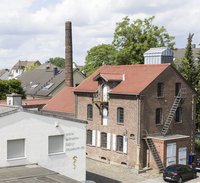Buchseite 12 aus der französischen Ausgabe von "De dissectione partium corporis humani libri tres" von 1545.
Autoren waren der französische Anatom, Verleger und Drucker Charles Estienne und der Anatom und Chirurg Étienne de La Rivière. Die Arbeit an diesem Anatomielehrbuch nahm über 10 Jahre in Anspruch. Gedruckt wurde die Ausgabe von Simon de Colines.
Das Bild zeigt die Rückenansicht eines menschlichen Skeletts. Erläuterungen zu den anatomischen Details stehen auf einer stilisierten vierkantigen Säule auf der rechten Seiten der Abbildung.
Der Titel "DE LANATOMIE, ET DISSEC. DES PARTIES" steht am oberen Bildrand.
en

